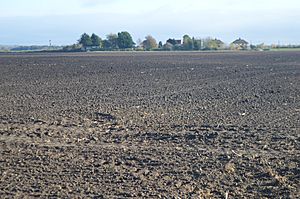Shippea Hill SSSI facts for kids
| Site of Special Scientific Interest | |
 |
|
| Area of Search | Cambridgeshire |
|---|---|
| Interest | Geological |
| Area | 27.6 hectares |
| Notification | 1989 |
| Location map | Magic Map |
Shippea Hill SSSI is a special place in Cambridgeshire, England. It is located east of Ely. This area is known as a Site of Special Scientific Interest (SSSI). It covers about 27.6 hectares, which is roughly the size of 40 football fields! Shippea Hill is important because of its unique geology. It is also a Geological Conservation Review site, meaning it's recognized for its important rocks and landforms.
Contents
What is Shippea Hill SSSI?
A Site of Special Scientific Interest (SSSI) is a protected area in the United Kingdom. These sites are chosen because they have rare wildlife, plants, or important geological features. Shippea Hill is special for its geology. This means scientists study the rocks, soil, and layers of earth there. These layers tell us about Earth's history over thousands of years.
Why is Shippea Hill Special?
Shippea Hill is very important for understanding the history of the Fens. The Fens are a very flat, low-lying area of eastern England. Scientists study the layers of soil and sediment at Shippea Hill. These layers were formed during the Holocene epoch. The Holocene is the time period since the last major ice age, which began about 11,700 years ago.
In the 1930s, scientists first studied the layers at Shippea Hill. They used these layers to figure out how the Fens changed over time. For example, they learned about the "Fen Clay transgression." This was a time when the sea moved into the Fens during the Holocene. Even though scientists have learned more since then, Shippea Hill still helps us understand how our landscape has changed over thousands of years.
Studying the Past at Shippea Hill
In the early 1930s, important research happened at Shippea Hill. A famous archaeologist named Grahame Clark worked with two botanists, Harry and Margaret Godwin. Botanists are scientists who study plants. They wanted to learn more about how ancient people lived. They combined archaeology (studying human history through digging up old things) with new scientific methods. These methods came from geology and plant science.
They created the Fenland Research Committee. This group studied how the environment changed after the last ice age. They looked at how these changes affected the people who lived in the Fens during the Mesolithic period. The Mesolithic period was a time in human history when people were hunter-gatherers, living before farming began. The first big project for this group was digging and studying at Shippea Hill. Their work helped us understand how people lived in the Fens long ago and how they adapted to changes in their environment.
Who was Grahame Clark?
Grahame Clark (1907–1995) was a very important British archaeologist. He was one of the first to study the Mesolithic period in Britain. He believed that to truly understand ancient people, you needed to understand their environment. This is why he worked with scientists like the Godwins. He wanted to see how people lived alongside nature. His work at Shippea Hill was a great example of this new way of studying the past.
Visiting Shippea Hill
Today, Shippea Hill SSSI is on private land. This means there is no public access for visitors. The site has been filled in over the years and is now used as a field. Even though you cannot visit it, its history and the scientific discoveries made there are still very important.

